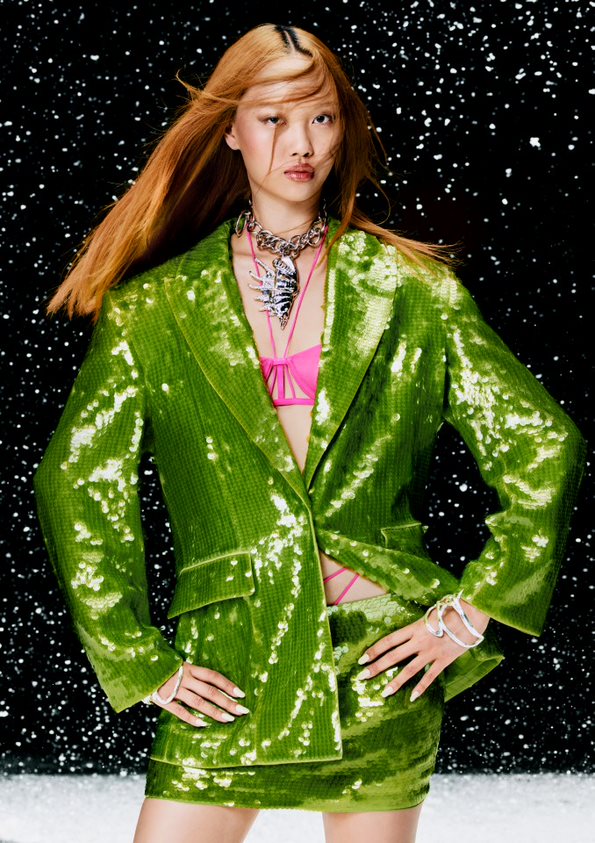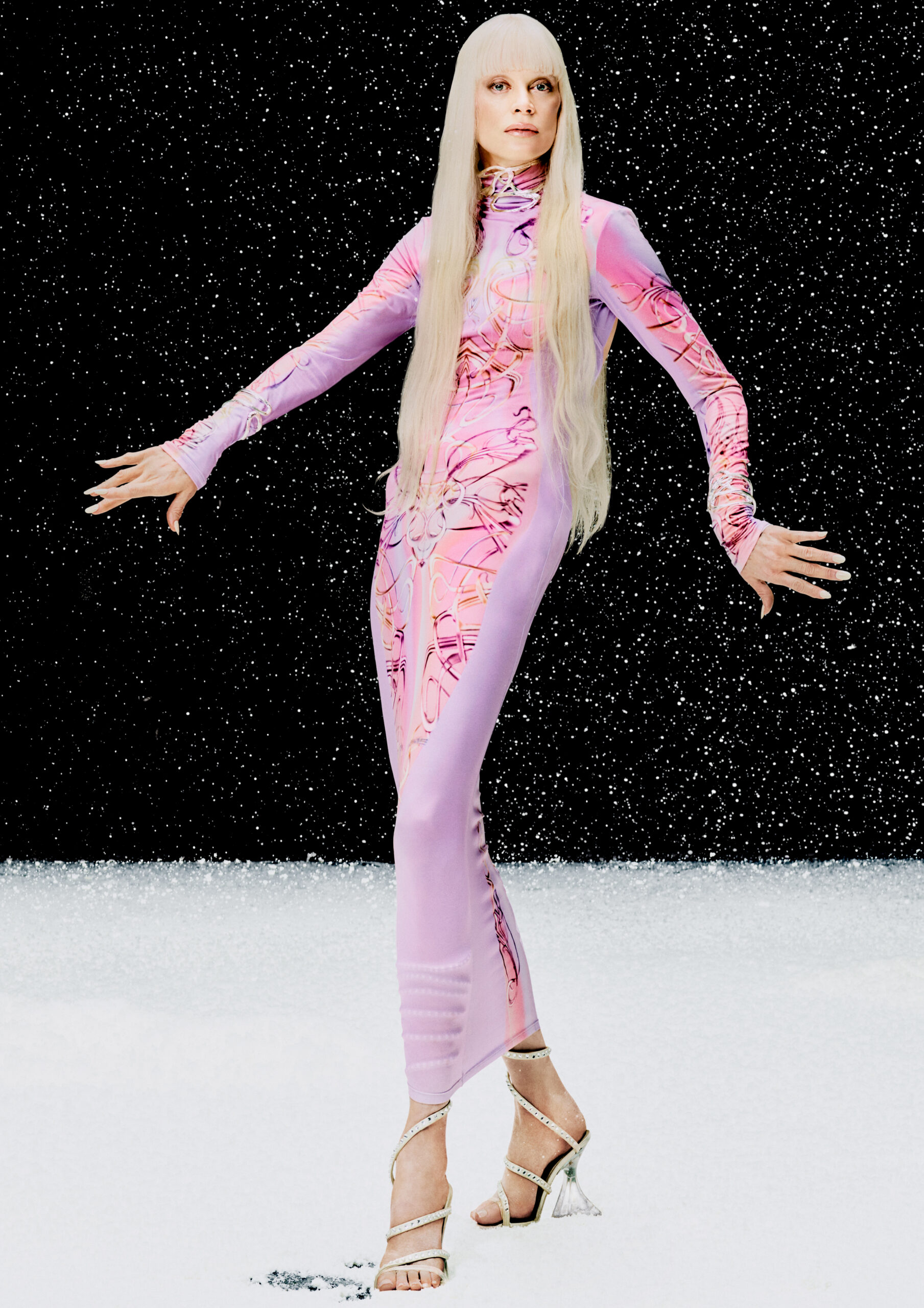In conversation with Ann-Sofia Johansson, H&M’s creative advisor about their latest innovation story

The concept of the metaverse can feel abstract, and in many ways, illusive — however, once removed from the ‘tech-bro’ conceptualisations and into the world of fashion and art; the creation of a digital landscape in which users can live out their greatest fantasies is, without a doubt, exciting! From video games to online dressing rooms, the metaverse is never simply “one thing” or “one experience”, but rather, a gateway for a multitude of opportunities beyond physical restrictions. Taking this freedom on, H&M, as a part of their Innovation Stories, has officially launched their meta-inspired collection. Blurring the boundaries between the on and offline, this collection celebrates, “the growth of the virtual fashion dimension” in which H&M have decided to “create vibrantly, with bold virtual counterparts to our physical collections”. Is it online, or is it offline? Is it virtual, or is it physical? Well, it is the lost binary of these two worlds which has inspired this project — as you can shop the collection, or experiment with the filters online now!
To celebrate H&M’s leap in the fashion landscape, we are happy to share with you a conversation with the creative advisor of the brand, Ann-Sofia Johansson. Explaining the inspiration behind this project, and the ongoing narrative of H&M’s Innovation Stories — delve into the meaning behind their metaverse below.


H&M has launched numerous sustainability-led projects over the last few years. Why did you decide the time was right to launch Innovation Stories in early 2021?
At H&M, we are always striving towards our goal of a circular fashion system. We were one of the first to explore the use of more sustainably sourced materials such as organic cotton, recycled polyester and Tencel more than 10 years ago. In 2013, we launched our pioneering Conscious Exclusive line of more sustainable eveningwear, releasing exciting and elevated collections every season. Our Innovation Stories concept allows us to develop our sustainability journey. The aim is to bring our customers closer to incredible innovations – whether that’s an energy-saving dyeing process, or a plant-based alternative to an animal fibre – and spotlight our work with scientists and developers, all while creating desirable, long-lasting and versatile designs. This is our eighth Innovation Stories collection and we’ve learnt so many lessons that will be implemented in future collections and across other areas of the business.
What has been the biggest challenge with Innovation Stories as a platform, and with this collection specifically?
The challenge is always keeping a long-term mindset. H&M regularly invests in new innovations and has collaborated with many start-ups, either as part of H&M Group’s Circular Innovation Lab or with H&M Foundation’s Global Change Award. We often spend years tracking the progress of a particular innovation so that once it has hit a scalable level, and guarantees the high quality we demand at H&M, we can use it in our collections. The design team has learnt to be flexible, and patient! For example, for this collection specifically, the team was inspired to create a “no-waste” dress that our pattern-cutter worked on for weeks, refining the design so that no off-cut scraps of waste were created. Working with circularity, you have to be persistent, you can’t just give up! We are thrilled with the results


What is the creative process like for a sustainable collection, and how does it differ from other collections you have designed in the past?
Innovation Stories has a dedicated design team that works alongside H&M’s sustainability department to bring the most sustainable fabrics and cutting-edge processes to our customers. The collections start the same way as any other fashion collection: the design team has a concept, maybe inspired by travel, or an art show, or just a mood – for this collection, we were feeling enthused by the metaverse. The team then creates a collection using the most sustainably sourced materials and processes at our disposal, in dialogue with the sustainability team and with our suppliers. This season we were also using H&M’s new The Circulator tool, which is a programme that helps designers make more circular decisions – for instance, the tool might suggest digital-printing instead of screen-printing for a particular garment. We’re hoping to make that tool available to the rest of the industry later this year. In general when it comes to the creative process, there’s a lot of flexibility required, and lots of communication with suppliers. And of course, we also welcome valuable feedback from our customers.
This collection explores the blurring of lines between the physical and digital worlds – can you explain the inspiration and assess how important virtual fashion will become for H&M in the future?
We were talking a lot as a team about the exciting possibilities of the metaverse, and how we hope the digital world will allow us to play with the transformative qualities of fashion to express ourselves. At the same time, I think we all have moments where we feel overwhelmed by screens – so we focused
on the tactility of the garments, inspired by the beauty of the physical world. In the end, we wanted to strike a balance between the digital world and the incredible opportunities virtual fashion offers, as well as the glamour of fashion that makes you want to get dressed up on a Saturday night. What’s clear is that virtual fashion allows for more creativity, as well as being inclusive, and having lots of sustainable benefits. H&M has already produced virtual fashion collections in the past, and we believe they allow us to engage with our customers in fun and innovative ways.
You’re often accused of greenwashing at H&M. How does H&M define circularity – what are some examples in this particular collection – and why is sustainability such a big focus for the company?
At H&M, sustainability has been a part of who we are for quite a while. As a global fashion company, we know we have a big responsibility to lead the change, both educating our customers and supporting a science-based approach within the industry. I think we all agree that we need to adjust the way we design, develop, produce, consume and dispose of fashion. But we believe we can only create effective change when we can collaborate with governments and other key industry players. Our circular vision plays an important role in our sustainability efforts: a circular business model maximises resources and minimizes waste, and we have set ourselves a goal to only use recycled or more sustainably sourced materials by 2030. With this collection, we thought about circularity in a really holistic way: we aimed to use materials that make use of waste and turn it into something beautiful; we used a lot of mono-fibres, so that garments can be more easily recycled when they reach the end of their life; and we made some pieces available for rental. Our development of The Circulator tool, which we plan to make available to the industry, is another example of our desire to collaborate: we know that when we share our knowledge, we can accomplish more.


